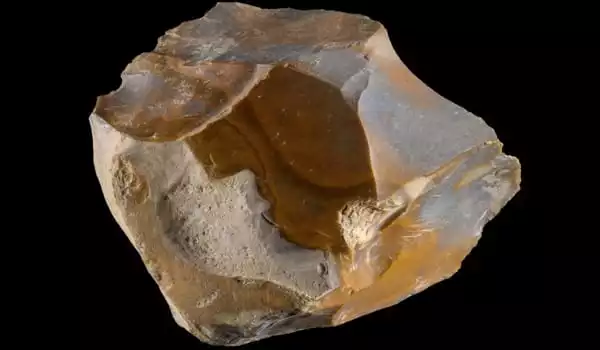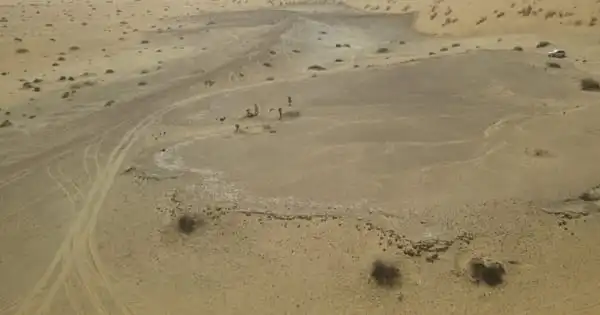A 1.5 million-year-old human vertebra unearthed in Israel’s Jordan Valley is the subject of a new study. According to the findings, early human migration from Africa to Eurasia occurred in waves rather than all at once.
A 1.5 million-year-old human vertebra discovered in Israel’s Jordan Valley has been presented in a new study led by experts from Bar-Ilan University, Ono Academic College, The University of Tulsa, and the Israel Antiquities Authority. According to a study published today (Wednesday, February 2) in the journal Scientific Reports, early human migration from Africa to Eurasia occurred in waves rather than all at once. Around 1.8 million years ago, the first wave reached the Republic of Georgia in the Caucasus. The second is documented in ‘Ubeidiya, in the Jordan Valley, south of the Sea of Galilee, about 1.5 million years ago.
Dr. Alon Barash of Bar-Ilan University’s Azrieli Faculty of Medicine, Professor Ella Been of Ono Academic College, Professor Miriam Belmaker of The University of Tulsa, and Dr. Omry Barzilai of the Israel Antiquities Authority led the study.
According to fossil evidence and DNA testing, human evolution began around six million years ago in Africa. Around two million years ago, ancient people – nearly modern, but not quite – began to move from Africa and spread over Eurasia, a phenomenon known as the “Out of Africa.” Ubeidiya, near Kibbutz Beit Zera in the Jordan Valley, is one of the sites where we have archaeological evidence for this dispersal.
We now have unambiguous proof of the occurrence of two distinct dispersal waves due to the difference in size and shape of the vertebra from ‘Ubeidiya and those found in the Republic of Georgia.
Dr. Alon Barash
The prehistoric site of ‘Ubeidiya is notable for archaeological and evolutionary studies since it is one of the few places where the early human exodus from Africa has been preserved. The site is the second oldest archaeological site outside of Africa, and it was investigated between 1960 and 1999 by multiple teams led by Professors M. Stekelis, O. Bar-Yosef, and E. Tchernov. The excavation yielded a diverse and uncommon collection of extinct animal bones and stone artifacts. There are fossils of a sabertoothed tiger, mammoths, and a gigantic buffalo, as well as animals that no longer exist in Israel, such as baboons, warthogs, hippopotamuses, giraffes, and jaguars. Stone and flint items made and used by ancient humans show resemblance to those discovered at sites in East Africa.
Belmaker and Barzilai recently resumed excavations in ‘Ubeidiya thanks to a funding from the National Science Foundation of the United States. The project use new absolute dating technologies to enhance the site’s dating and to investigate the region’s paleoecology and paleoclimate. Belmaker, a paleoanthropologist from The University of Tulsa’s Department of Anthropology, came across a human vertebra while studying the site’s fossils, which are now kept at the Hebrew University’s National Natural History Collections. The bone was discovered in 1966 and analyzed by Barash and Professor Ella Been. They determined it to be a human lumbar vertebra, the earliest fossil evidence of ancient human bones unearthed in Israel, dating back about 1.5 million years.

According to Barash, a human anatomy and evolution researcher at Bar-Ilan University’s Azrieli Faculty of Medicine, there is an ongoing discussion in the literature concerning whether the migration was a one-time event or occurred in multiple waves. This question has been answered by a fresh discovery from ‘Ubeidiya. “We now have unambiguous proof of the occurrence of two distinct dispersal waves due to the difference in size and shape of the vertebra from ‘Ubeidiya and those found in the Republic of Georgia.”
According to Barzilai, the chairman of the Israel Antiquities Authority’s Archaeological Research Department, “The Early Acheulean culture is associated with stone and flint artifacts from ‘Ubeidiya, such as handaxes made of Basalt, chopping tools, and flakes made of flint. It was previously assumed that the stone tools from ‘Ubeidiya and Dmanisi belonged to separate cultures: Early Acheulean in ‘Ubeidiya and Oldowan in Dmanisi. According to the findings of this new study, the two sectors were created by separate human species.”
Belmaker elaborated, “One of the key problems about human dispersal from Africa was the ecological circumstances that may have aided dispersal. Previous hypotheses argued that early people chose an African savanna or a new, more humid woodland habitat. Our latest discovery of separate human species in Dmanisi and ‘Ubeidiya is consistent with our previous discovery that climates vary between the two sites: ‘Ubeidiya is more humid and compatible with a Mediterranean climate, whereas Dmanisi is drier and compatible with savannah habitat. The fact that each group favored a different environment supports this study revealing two species, each producing a different stone tool culture.”
“The examination we performed revealed that the vertebra from ‘Ubeidiya belonged to a young person aged 6 to 12 years old who was tall for his age. If this child had grown to adulthood, he would have attained a height of more than 180 cm. This ancient human is comparable in size to other giant hominins found in East Africa, but it differs from the short-statured hominins found in Georgia “Been, a paleoanthropologist at Ono Academic College’s Faculty of Health Professions and a spinal evolution expert, explained his findings.
“So, it appears that we can identify at least two species of early humans outside of Africa during the period known as the Early Pleistocene. Each wave of migration represented a particular type of person based on look and shape, stone tool making technique and history, and ecological niche in which they lived “Barash concluded.





